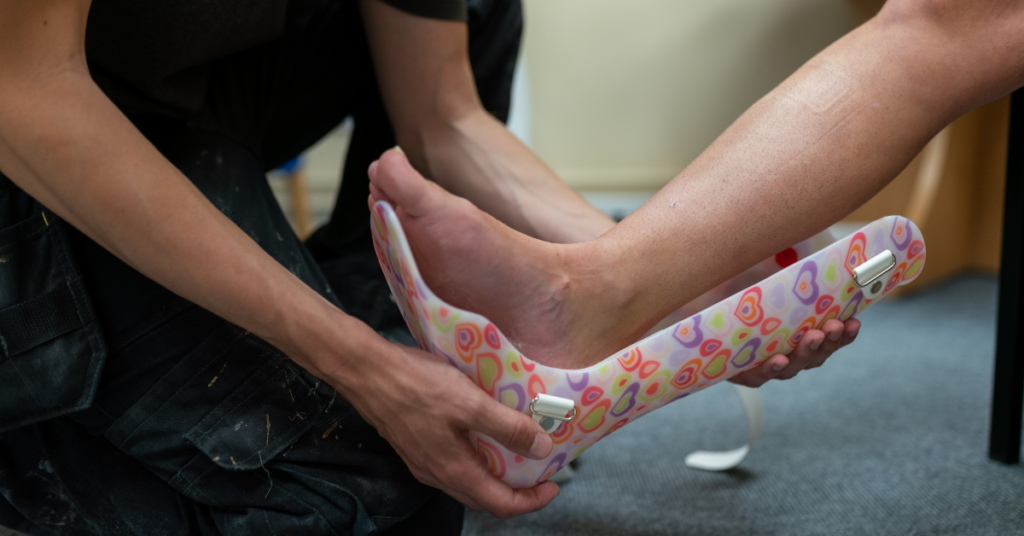Table of Contents
Exercise Daily – Wondering about how long does it take for a sprained ankle to heal? If so, then let’s have an insightful overview of the healing duration of a sprained ankle.
Ankle sprains can be quite painful, especially if they prevent you from participating in physical activities. Ankle injuries are much too prevalent in the United States.
According to a review of recent studies, about 2 million acute ankle sprains arise every year in the United States, making it one of the most frequent musculoskeletal injuries.
In addition, when you consider that a mild ankle sprain may be healed in 3 to 4 weeks while a more serious injury can take 3 to 6 months to recover, choosing the proper therapy is critical.
What Is A Sprained Ankle?
A sprained ankle is a type of injury that happens when your ankle is rolled, twisted, or turned in an uncomfortable manner. When you fall, the ligaments that keep your ankle bones together can be stretched or torn, which can cause pain.
Ligaments assist in the stabilization of joints and the prevention of excessive movement. It is possible to sustain a sprained ankle if the ligaments are pushed to move beyond their usual range of motion.
The majority of sprained ankles are caused by damage to the ligaments on the outside of the foot. The degree of a sprained ankle determines the course of treatment be administered.
Despite the fact that self-care methods and over-the-counter pain medicines may be sufficient, a medical examination may be required to establish how seriously you’ve sprained your ankle and to select the most effective course of therapy for you.
Before moving towards “how long does it take for a sprained ankle to heal,” let’s take a look at what causes it.
What Cause A Sprained Ankle?

An ankle sprain occurs when the ankle is pushed to shift out of its normal position, resulting in strained or torn ligaments (s). A sprained ankle can be caused by a variety of factors, including:
- Twisting your ankle as a result of a fall
- working out or doing exercise programs on an uneven surface
- Someone steps on your foot or lands on your foot, which may happen rather frequently in sporting activities.
- Making a quick pivot or leap and then landing on your foot with difficulty
- Footwear that doesn’t fit correctly, or shoes with excessive heels. Both of these factors might make your ankles more susceptible to injury.
What Are the Symptoms of A Sprained Ankle?
It is important to note that the signs and symptoms of a sprained ankle differ depending on the severity of the injury. They may include the following:
Experiencing discomfort, especially when placing weight on the impacted foot
- When you touch the ankle, you will feel tenderness.
- Swelling
- Bruising
- Limited mobility
- Instability of the ankle joint
- When the injury occurs, there is a popping sensation or sound.
How Long Does It Take For A Sprained Ankle To Heal?

In the event that you have been told that you have an ankle sprain, you may be wondering how serious the sprain is and how long it will take for the injury to heal.
A sprain of the ankle includes one or several of the ligaments that link your leg bones to your foot bones.
Keeping your bones in place is the job of your ankle ligaments. When you sprain your ankle, you are causing a ligament to strain or tear.
Sampsell explains that sprains are classified according to their severity, which ranges from moderate to severe. The following are the approximate recovery timeframes associated with each of these grades:
| Type of ankle sprain | Approximate healing time |
| First degree or grade 1 (mild) | 3 to 5 weeks |
| Second degree or grade 2 (moderate) | 4 to 6 weeks |
| Third degree or grade 3 (severe) | 3 to 6 months |
1st Grade Sprain of Ankle
Sampsell explains that a first-degree sprain is a little tear of a ligament that causes only moderate swelling and discomfort and that it recovers rather fast.
It is common for first-degree sprains to take three weeks to recover. However, some people recover in a shorter period of time, while others require 4 or 5 weeks.
2nd Grade Sprain of Ankle
A second-degree sprain is a bit more serious, according to Sampsell, and it often involves 50 percent of the ligament ripping, as well as increased inflammation, discomfort, and loss of movement in the affected area.
When you are diagnosed with a second-degree sprain, you should expect to be out of action for more than four weeks. Second-degree sprains often recover in 4 to 6 weeks, although they might take longer.
3rd Grade Sprain of Ankle
A third-degree sprain is a full tear, and according to Sampsell, it will take significantly longer to recover than the first two. It will take some patience to recover from this sprain since it can take anywhere from 3 to 6 months to fully recover.
We hope that you now know how long does it take for a sprained ankle to heal.
How To Recover From A Sprained Ankle?
Use of First Aid
A temporary bandage can assist in stabilizing the joint and preventing it from sliding about.
Anyone who believes they have injured their ankle should seek medical attention immediately.
Avoid placing any weight on the ankle since doing so increases the likelihood of breaking bones and suffering additional injuries as a result. Sit in a comfortable posture, with the ankle raised to minimize swelling, and rest your arms on the table.
Nonsteroidal anti-inflammatory medications, or NSAIDs, such as ibuprofen, can also be used to reduce swelling and discomfort in the joints.
Wear a temporary brace or bandage to keep the joint still and protect it from shifting until you can get to the doctor.
Using crutches to assist with balance and movement while allowing the ankle to rest is something some individuals find useful.
It is difficult to identify an ankle sprain only on the basis of its symptoms. As a result, a person should consult with a physician.
The majority of family physicians and doctors at urgent care clinics are capable of diagnosing a sprained ankle in a short amount of time. If the damage is severe, they may send the patient to an orthopedist or a foot and ankle surgeon for further treatment.
Tips to Speed Up Healing

It is possible that the techniques of home care listed below will support a quicker recovery while also helping to prevent additional injuries.
RICE
Anyone who’s looking for how long does it take for a sprained ankle to heal should know about the RICE technique.
Rest, ice, compression, and elevation (RICE) are the letters that make up the acronym. In the days following an injury, doctors frequently prescribe the use of these techniques to help reduce swelling and inflammation.
Rest
Resting the ankle is essential for healing, and wearing a brace can assist in stabilizing the damaged region while you are recovering. When you try to go back into sports or other activities too soon, you increase your chances of being injured again.
Ice
Using an ice pack on the injury may help to decrease blood flow to the area and alleviate pain and swelling.
According to the American Academy of Family Physicians, putting an ice pack on the sprain for 10–20 minutes at a time will help to reduce swelling. Before applying the pack to the skin, wrap it in a towel to protect it.
The National Athletic Trainers’ Association, on the other hand, conducted a review of the evidence regarding the use of ice for injuries in 2013. They discovered that, despite the fact that doctors frequently advocate using ice, there is only minimal data to support its efficacy.
If ice does not ease your symptoms, try some of the additional therapies available.
Compression
Compression assists in the stabilization of the damaged joint as well as the reduction of inflammation.
Wrapping a bandage over the damaged ankle may be an option. A good bandage should be snug but not too tight, or else it might induce discomfort or numbness.
If you ask anyone about how long does it take for a sprained ankle to heal, he/she would recommend compression for sure.
Elevation
Elevating an injured ankle helps to prevent the buildup of fluid in the joint. This can assist in reducing swelling, which in turn can help to lessen discomfort.
Try sleeping with your feet and ankles pushed up on pillows at a height higher than your heart. When sitting or resting, elevate the foot and ankle using cushions or a footrest to protect them from swelling.
Heat
Heat improves blood flow to an injured area, which can aid in the healing process. Some people also report that it aids in the relaxation of tight muscles, therefore alleviating pain and stress.
But avoid using heat while your ankle is still swollen since this will just promote inflammation and impede the healing process.
Once the swelling has reduced, attempt using a heat pack for fifteen to twenty minutes.
Intermittent use of heat and ice packs might provide relief for some people. Only attempt this when the swelling has subsided – not soon following the injury.
Stretching
Stretching is an excellent way, especially when you are looking answer to how long does it take for a sprained ankle to heal.
Whenever a person has an ankle injury, it puts surrounding muscles and other tissues at risk of harm. This is especially true if the tissues have grown weak as a result of lack of usage.
Stretching helps to maintain your muscles healthy and limber. It also promotes increased blood circulation in the region, which may aid in the healing of the ankle.
At least three times each day, gently extend the ankle by moving it in all directions with your foot. You may also experiment with flexing your foot forward and then backward or rolling your foot clockwise and then counterclockwise.k
Avoiding overextending the ankle or moving it in any way that causes pain is critical, though.
Walking
Ankle sprains can cause significant pain and swelling, especially in the early period. It may become hard for a person to put any weight on the joint as a result of this.
Walking might help to speed up the healing process when the swelling subsides. Walking small distances within the house is a good place to start. Then, when your ankle begins to recover, progressively increase your distances as you get stronger.
Walking, on the other hand, may necessitate holding the damaged ankle in an odd position or twisting the body in order to avoid placing excessive pressure on the joint. If this is the case, you should wait 1–2 days before attempting again.
Exercise
Not only with “how long does it take for a sprained ankle to heal,” but exercise also helps with the strengthening of your muscles.
Exercise can help you regain your strength and balance while also preventing the muscles in the affected area from becoming weak. This can help to minimize the likelihood of another sprain occurring.
After the swelling has subsided and walking is no longer painful, it may be a good idea to begin stretching and strengthening the ankle.
A person can try completing the following exercises for 10–15 minutes every other day for 10–15 minutes to see how they feel.
Standing on a low step with the heels dangling backward over the edge is a good idea. Drop the heels a little and hold the position for a few seconds more. After that, raise the heels higher than the toes.
Try to maintain your balance on one foot for 30–60 seconds before switching sides to build equal strength in both joints and muscles.
Gently oppose the movement with an elastic workout band wrapped over the foot. Move the ankle in a clockwise direction first, then in a counterclockwise direction.
With one leg in front of the other, play catch while maintaining your balance.
Massage
Massage can assist in alleviating pain while also increasing blood flow to the injured part of the body.
An individual should seek the counsel of a trained massage therapist if the injury is very serious or painful to deal with.
Moving forward with how long does it take for a sprained ankle to heal, massage can provide a lot of support in this.
When dealing with less serious injuries, a person might attempt at-home light massage. Some patients find that massaging the sole of the foot or the heel of the foot helps to relieve their symptoms.
Others like to massage around or slightly above the ankle, depending on their preference.
If rubbing the region causes discomfort or worsens the symptoms, the individual should cease massaging it.
Physical Therapy
Any person who has long-term discomfort following a major sprain, as well as anybody who has a history of similar injuries, may benefit from physical therapy.
In order to discover weak muscles and other problems that might cause discomfort and raise the risk of injury, a physical therapist will do an examination of the person’s ankle.
They will also inquire about the individual’s lifestyle, including whether or not they participate in sports.
The physical therapist will utilize this information to develop a personalized workout regimen that will aid in the healing process and reduce pain levels.
How to Prevent Ankle Sprains?
Maintain Your Balance

One strategy to avoid ankle sprains is to work on your balance and coordination. Understanding how your body’s internal equilibrium operates is essential to doing this.
For starters, your vision has an influence on your balance since your body moves in response to what it perceives based on anticipation, experience, and expectations.
When you are not able to see, your body relies on its capacity to sense where you are in space, which is known as proprioception, to keep you safe.
To prevent circumstances like “how long does it take for a sprained ankle to heal,” you should maintain your balance.
Throughout your body, there are 45 miles of nerve tissue that transmit information. These nerves also assist in the maintenance of your balance.
Fortunately, there are methods for improving your balance, which can prevent the onset of the injury. One method of accomplishing this is to practice balancing on one foot while brushing your teeth or conducting mild upper-body activity on a regular basis.
Because of this, the surrounding muscles in your ankle/leg/hip and even lumbar stabilizers will continue to adapt and teach themselves to activate and regulate your emotions.
Additionally, physical therapy can assist with the improvement of more significant balance problems and/or vestibular disorders as well.
Make Your Core More Stable
Your ability to move depends on the strength and function of your hips and trunk. Consider the sensation of running gently and then quickly shifting direction.
If you don’t have enough core strength, your body will most likely continue to move since you won’t have enough hip control.
When your body weight exceeds the ability of your foot and ankle to regulate the situation, the ultimate consequence might be a rolled ankle and/or a falling.
In order to achieve this, it is critical to concentrate on hip and abdominal/back strengthening throughout exercises.
Increase the Strength of Your Ankles
The development of ankle strength is an excellent preventive measure. It is possible to do this with single-leg strengthening exercises, including squats, lunges, dips, and rubber band strengthening routines, among others.
A more stable foundation will make it simpler to stay on your feet and maintain control over your body posture.
Strengthening your ankles prevents you from sprain and asking about how long does it take for a sprained ankle to heal.
Increase Your Level of Flexibility
It is critical to strike a balance between strength and flexibility. After a brief warm-up, simple stretching for 30-60 seconds will help alleviate pain and improve sufficient mobility in the lower leg.
Due to the fact that ligament or joint hypermobility is a sign of ankle sprain, stretching should be done gently and pleasantly thereafter.
Continual and Progressive Activity
It is not a good idea to embark on a multi-mile trek out of the blue without first conditioning your body. If you know you will be participating in a new sport or activity in the near future, it is a good idea to prepare your body in advance.
This does not imply full-body training but rather getting into the habit of regular exercise while simulating the activity you want to pursue.
Because muscle memory plays a role in ankle sprains, practicing the action or sport in which you are involved can assist you in avoiding injury.
Prepare Yourself for It
Don’t be afraid to put a brace or tape on your ankle to keep it from becoming injured again. Braces and tapes can make a significant impact on the maintenance of health because they provide additional support.
Furthermore, bracing encourages input to your body, allowing you to maintain proper ankle alignment while doing your preferred activity.
How Long Does It Take For A Sprained Ankle To Heal – FAQs
How long does it take for a torn ligament in the ankle to heal?
The 1st degree sprained ankle takes 3 to 5 weeks to fully recover. Moreover, 2nd degree and 3rd-degree ankle sprains take 4 to 6 weeks and 3 to 6 months, respectively.
The healing process of sprained ankle highly depends on the severity of the injury.
How long does a sprained ankle stay swollen?
Even in the case of more severe ankle sprains, swelling will often subside on its own within two weeks after the initial injury. If you experience severe swelling as a result of this, you should contact your doctor about your ankle injury.
However, to reduce swelling quickly, you can check some of the tips we explained in this guide.
How long should you stay off a sprained ankle?
When you have a mild sprain, you should start feeling better within a few days to a week and be completely healed within six weeks.
Ankle sprains that are more severe may require more than a few weeks or even months to heal completely.
In severe cases, crutches may be required to alleviate the agonizing discomfort. It is possible that a return to routine activities will be postponed for several weeks or months.
How long should it take for a sprained ankle to heal?
When treated with rest and non-surgical measures, mild, low-grade ankle sprains will often recover in one to three weeks ( such as applying ice).
It may take between three and four weeks to recover from a somewhat severe injury. Because of the restricted blood supply to the ankle ligaments, more serious ankle injuries may take between three and six months to heal, depending on their severity.
How long should a sprained ankle hurt?
During the early stage of the injury, it is possible that you may feel severe pain. However, in most cases, when the swelling subsides, your pain also goes away.
If you have a lot of pain, you should consult a physician.
How to heal a sprained ankle fast in 2 days?
The best way to heal a sprained ankle quickly is by using a RICE technique. It involves Rest, Ice, Compression, and Elevation.
How long does a grade 2 ankle sprain take to heal?
Grade 2 ankle sprains entail more severe damage to the ligament and can take up to 4-6 weeks to heal completely, preventing the athlete from returning to sports.






